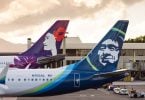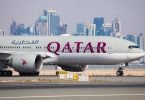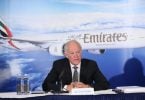Boeing’s Rival Airbus based in Germany and France may be taking Boeing’s failure and corner-cutting corporate attitude toward building safe passenger jets to the bank, especially after Boeing’s move into the Pentagon neighborhood.
Boeing has a proud history of manufacturing aircraft for commercial passengers or freight, for defense, space, and even flying boats.
In 2023 Boeing moved to Arlington, Virginia, the greater Washington DC area. There seems to be a more obvious reason behind this move – the Pentagon. The US Military is the largest customer for Boeing and their headquarters are also in Washington DC.
A threat of war requires lots of new military planes
A fast-developing global threat of war and an unsafe world require fast development of military equipment including military planes.
Is Boeing about to give up on passenger jets?
Whether the company is planning to giving up on building safe passenger jets, or if after so much frustration the profitable thing to do is concentrate on the defense and space part of the business, such speculations may become the ugly reality for the largest airline manufacturer in the world.
Adding to the reason for this change may be the frustration, pending criminal actions for cutting corners on putting profit over safety or better profit over conscience after 346 people were recently killed in two unnecessary Boeing 737 Max crashes.
The Boeing 737, first known as the “City Jet” for short and medium distances, built in the 60′ was one of the most successful aircraft in the world. This continued until two fatal crashes in 2018 and 2019, that killed 346 people.
The trouble version of the B737 was called B737- Max because of its extended version. Boeing’s design choices and quality struggles have likely contributed to the current predicament for the company to look at better income sources – the United States Military, and its allies around the globe.
The current geo-political reality is an ideal situation for such a restructuring.
Three years ago the Boeing Company (Boeing) had agreed with the U.S. Department of Justice to resolve a criminal charge related to a conspiracy to defraud the Federal A viation Administration’s Aircraft Evaluation Group (FAA AEG) in connection with the FAA AEG’s evaluation of Boeing’s 737 MAX airplane.
Af ter the two Boeing 737 Max crashes in Indonesia and Ethiopia , it came to light, that there were shortcomings in cutting corners getting this aircraft certified.
This resulted in civil and criminal charges. Boeing executives only escaped criminal charges by agreeing on a deferred deal with the US Justice Department that would have criminal charges dismissed if Boeing was able to work without having any more safety issues after this for years.
It took less than three years for the next big thing to happen.
The agreement for Boeing to avoid criminal prosecution with the US Justice Department and Boeing was signed on January 7, 2021.
On January 5, 2024, an Alaska Airlines flight almost crashed on a flight from Portland, OR to Ontario, CA after an emergency door fell out. The reason behind it may constitute a violation of this deferred agreement.
In addition, more dangerous shortcomings came to light, possibly avoiding more incidents or possible crashes. Considering the Boeing 737 MAX was also used on long 5 1/2 hour overwater flights to Hawaii , the question was asked if flying Alaska Airlines on a B737-Max from Honolulu to California, Oregon, or Washington State was a risky decision.
eTN Video Interview with the Expert:
Are Boeing B737 Max Planes Still Safe to Fly?
In a video interview with the Breaking News Show, Paul Hudson and Gregory Travis from flyersrights.org explained, why Boeing may not always put safety before profit, and shared the background of why the company may care more about its military side of the business.
This is the information published by the Office of Public Affairs for the U.S. Department of Justice:
The Boeing Company (Boeing) has agreed with the Department of Justice to resolve a criminal charge related to a conspiracy to defraud the Federal Aviation Administration’s Aircraft Evaluation Group (FAA AEG) in connection with the FAA AEG’s evaluation of Boeing’s 737 MAX airplane.
Boeing, a U.S.-based multinational corporation that designs, manufactures, and sells commercial airplanes to airlines worldwide, entered into a deferred prosecution agreement (DPA) in connection with a criminal information filed today in the Northern District of Texas.
The criminal information charges the company with one count of conspiracy to defraud the United States. Under the terms of the DPA, Boeing will pay a total criminal monetary amount of over $2.5 billion, composed of a criminal monetary penalty of $243.6 million, compensation payments to Boeing’s 737 MAX airline customers of $1.77 billion, and the establishment of a $500 million crash-victim beneficiaries fund to compensate the heirs, relatives, and legal beneficiaries of the 346 passengers who died in the Boeing 737 MAX crashes of Lion Air Flight 610 and Ethiopian Airlines Flight 302.
“The tragic crashes of Lion Air Flight 610 and Ethiopian Airlines Flight 302 exposed fraudulent and deceptive conduct by employees of one of the world’s leading commercial airplane manufacturers,” said Acting Assistant Attorney General David P. Burns of the Justice Department’s Criminal Division.
“Boeing’s employees chose the path of profit over candor by concealing material information from the FAA concerning the operation of its 737 Max airplane and engaging in an effort to cover up their deception. This resolution holds Boeing accountable for its employees’ criminal misconduct, addresses the financial impact to Boeing’s airline customers, and hopefully provides some measure of compensation to the crash victims’ families and beneficiaries.”
Misleading Statements, and Half-Truths
“The misleading statements, half-truths, and omissions communicated by Boeing employees to the FAA impeded the government’s ability to ensure the safety of the flying public,” said U.S. Attorney Erin Nealy Cox for the Northern District of Texas. “This case sends a clear message: The Department of Justice will hold manufacturers like Boeing accountable for defrauding regulators – especially in industries where the stakes are this high.”
“Today’s deferred prosecution agreement holds Boeing and its employees accountable for their lack of candor with the FAA regarding MCAS,” said Special Agent in Charge Emmerson Buie Jr. of the FBI’s Chicago Field Office.
“The substantial penalties and compensation Boeing will pay, demonstrate the consequences of failing to be fully transparent with government regulators. The public should be confident that government regulators are effectively doing their job, and those they regulate are being truthful and transparent.”
“We continue to mourn alongside the families, loved ones, and friends of the 346 individuals who perished on Lion Air Flight 610 and Ethiopian Airlines Flight 302.
The deferred prosecution agreement reached today with The Boeing Company is the result of the Office of Inspector General’s dedicated work with our law enforcement and prosecutorial partners,” said Special Agent in Charge Andrea M. Kropf, Department of Transportation Office of Inspector General (DOT-OIG) Midwestern Region.
“This landmark deferred prosecution agreement will forever serve as a stark reminder of the paramount importance of safety in the commercial aviation industry, and that integrity and transparency may never be sacrificed for efficiency or profit.”
As Boeing admitted in court documents, Boeing—through two of its 737 MAX Flight Technical Pilots—deceived the FAA AEG about an important aircraft part called the Maneuvering Characteristics Augmentation System (MCAS) that impacted the flight control system of the Boeing 737 MAX.
Because of their deception, a key document published by the FAA AEG lacked information about MCAS, and in turn, airplane manuals and pilot training materials for U.S.-based airlines lacked information about MCAS.
Boeing began developing and marketing the 737 MAX in or around June 2011. Before any U.S.-based airline could operate the new 737 MAX, U.S. regulations required the FAA to evaluate and approve the airplane for commercial use.
In connection with this process, the FAA AEG was principally responsible for determining the minimum level of pilot training required for a pilot to fly the 737 MAX for a U.S.-based airline, based on the nature and extent of the differences between the 737 MAX and the prior version of Boeing’s 737 airplane, the 737 Next Generation (NG).
At the conclusion of this evaluation, the FAA AEG published the 737 MAX Flight Standardization Board Report (FSB Report), which contained relevant information about certain aircraft parts and systems that Boeing was required to incorporate into airplane manuals and pilot training materials for all U.S.-based airlines.
The 737 MAX FSB Report also contained the FAA AEG’s differences-training determination. After the 737 MAX FSB Report was published, Boeing’s airline customers were permitted to fly the 737 MAX.
Within Boeing, the 737 MAX Flight Technical Team (composed of 737 MAX Flight Technical Pilots) was principally responsible for identifying and providing to the FAA AEG all information that was relevant to the FAA AEG in connection with the FAA AEG’s publication of the 737 MAX FSB Report.
Because flight controls were vital to flying modern commercial airplanes, differences between the flight controls of the 737 NG and the 737 MAX were especially important to the FAA AEG for purposes of its publication of the 737 MAX FSB Report and the FAA AEG’s differences-training determination.
In and around November 2016, two of Boeing’s 737 MAX Flight Technical Pilots, one who was then the 737 MAX Chief Technical Pilot and another who would later become the 737 MAX Chief Technical Pilot, discovered information about an important change to MCAS.
Rather than sharing information about this change with the FAA AEG, through these two 737 MAX Flight Technical Pilots
Boeing concealed this information and deceived the FAA AEG about MCAS.
Because of this deceit, the FAA AEG deleted all information about MCAS from the final version of the 737 MAX FSB Report published in July 2017.
In turn, airplane manuals and pilot training materials for U.S.-based airlines lacked information about MCAS, and pilots flying the 737 MAX for Boeing’s airline customers were not provided any information about MCAS in their manuals and training materials.
Lion Air Crash
On Oct. 29, 2018, Lion Air Flight 610, a Boeing 737 MAX, crashed shortly after takeoff into the Java Sea near Indonesia. All 189 passengers and crew on board died.
Following the Lion Air crash, the FAA AEG learned that MCAS activated during the flight and may have played a role in the crash.
The FAA AEG also learned for the first time about the change to MCAS, including the information about MCAS that Boeing concealed from the FAA AEG.
Meanwhile, while investigations into the Lion Air crash continued, the two 737 MAX Flight Technical Pilots continued misleading others—including Boeing and the FAA—about their prior knowledge of the change to MCAS.
Ethiopian Air crash
On March 10, 2019, Ethiopian Airlines Flight 302, a Boeing 737 MAX, crashed shortly after takeoff near Ejere, Ethiopia. All 157 passengers and crew on board died.
Following the Ethiopian Airlines crash, the FAA AEG learned that MCAS activated during the flight and may have played a role in the crash. On March 13, 2019, the 737 MAX was officially grounded in the U.S., indefinitely halting further flights of this airplane by any U.S.-based airline.
Boeing to Cooperate with the Fraud Department
As part of the DPA, Boeing has agreed, among other things, to continue to cooperate with the Fraud Section in any ongoing or future investigations and prosecutions.
As part of its cooperation, Boeing is required to report any evidence or allegation of a violation of U.S. fraud laws committed by Boeing’s employees or agents upon any domestic or foreign government agency (including the FAA), regulator, or any of Boeing’s airline customers.
In addition, Boeing has agreed to strengthen its compliance program and to enhance compliance program reporting requirements, which require Boeing to meet with the Fraud Section at least quarterly and to submit yearly reports to the Fraud Section regarding the status of its remediation efforts, the results of its testing of its compliance program, and its proposals to ensure that its compliance program is reasonably designed, implemented, and enforced so that it is effective at deterring and detecting violations of U.S. fraud laws in connection with interactions with any domestic or foreign government agency (including the FAA), regulator, or any of its airline customers.
The department reached this resolution with Boeing based on a number of factors, including the nature and seriousness of the offense conduct; Boeing’s failure to timely and voluntarily self‑disclose the offense conduct to the department; and Boeing’s prior history, including a civil FAA settlement agreement from 2015 related to safety and quality issues concerning the Boeing’s Commercial Airplanes (BCA) business unit.
In addition, while Boeing’s cooperation ultimately included voluntarily and proactively identifying to the Fraud Section potentially significant documents and Boeing witnesses, and voluntarily organizing voluminous evidence that Boeing was obligated to produce, such cooperation, however, was delayed and only began after the first six months of the Fraud Section’s investigation, during which time Boeing’s response frustrated the Fraud Section’s investigation.
The department also considered that Boeing engaged in remedial measures after the offense conduct, including:
(i) creating a permanent aerospace safety committee of the Board of Directors to oversee Boeing’s policies and procedures governing safety and its interactions with the FAA and other government agencies and regulators;
(ii) creating a Product and Services Safety organization to strengthen and centralize the safety-related functions that were previously located across Boeing;
(iii) reorganizing Boeing’s engineering function to have all Boeing engineers, as well as Boeing’s Flight Technical Team, report through Boeing’s chief engineer rather than to the business units; and
(iv) making structural changes to Boeing’s Flight Technical Team to increase the supervision, effectiveness, and professionalism of Boeing’s Flight Technical Pilots, including moving Boeing’s Flight Technical Team under the same organizational umbrella as Boeing’s Flight Test Team, and adopting new policies and procedures and conducting training to clarify expectations and requirements governing communications between Boeing’s Flight Technical Pilots and regulatory authorities, including specifically the FAA AEG.
Boeing also made significant changes to its top leadership since the offense occurred.
The department ultimately determined that an independent compliance monitor was unnecessary based on the following factors, among others:
(i) the misconduct was neither pervasive across the organization, nor undertaken by a large number of employees, nor facilitated by senior management;
(ii) although two of Boeing’s 737 MAX Flight Technical Pilots deceived the FAA AEG about MCAS by way of misleading statements, half-truths, and omissions, others in Boeing disclosed MCAS’s expanded operational scope to different FAA personnel who were responsible for determining whether the 737 MAX met U.S. federal airworthiness standards;
(iii) the state of Boeing’s remedial improvements to its compliance program and internal controls; and
(iv) Boeing’s agreement to enhanced compliance program reporting requirements, as described above.
The Chicago field offices of the FBI and the DOT-OIG investigated the case, with the assistance of other FBI and DOT-OIG field offices.
Trial Attorneys Cory E. Jacobs and Scott Armstrong, Assistant Chief Michael T. O’Neill of the Fraud Section, and Assistant U.S. Attorney Chad E. Meacham of the Northern District of Texas are prosecuting this case.
Boeing would be avoiding criminal penalties if it followed all security guidelines for years without new shortcomings.
FASCINATING INTERVIEW with Paul Hudson: Why Boeing 737 Max is still not safe
Paul Hudson from flyersrights.org in an interview with eTurboNews three years ago predicted that the B737 Max was still not safe.






















